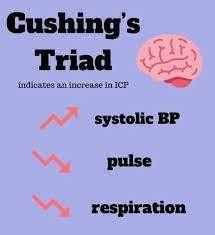While reviewing the clinical history of a client with brain injury, the nurse finds that there is a periorbital ecchymosis, which is referred to as raccoon eyes. The client also has leakage of cerebrospinal fluid (CSF) from the nose. Which fracture should the nurse suspect in the client?
Depressed fracture
Basilar skull fracture
Linear fracture
Frontal fossa fracture
The Correct Answer is B
Choice A rationale: Often results from direct trauma to the skull, but not typically associated with CSF leakage or raccoon eyes.
Choice B rationale: Basilar skull fractures, particularly involving the anterior or middle fossa, can lead to CSF leakage from the nose (rhinorrhea) and periorbital ecchymosis (raccoon eyes).
Choice C rationale: A simple fracture line without displacement, less likely to cause CSF leakage and raccoon eyes.
Choice D rationale: Less commonly associated with CSF leakage and periorbital ecchymosis compared to basilar skull fractures.
Nursing Test Bank
Naxlex Comprehensive Predictor Exams
Related Questions
Correct Answer is C
Explanation
Choice A rationale: Performing active range of motion exercises may not be safe or appropriate immediately following a hemorrhagic stroke.
Choice B rationale: Maintaining the head of bed flat or at a 30-degree position might be used for ischemic strokes but not necessarily for hemorrhagic strokes.
Choice C rationale: Teaching measures to avoid the Valsalva maneuver (straining during activities like defecation) helps prevent sudden increases in intracranial pressure, which can be detrimental after a hemorrhagic stroke.
Choice D rationale: Monitoring for Battle's sign (bruising behind the ears associated with basilar skull fracture) is not relevant in the care of a hemorrhagic stroke.
Correct Answer is C
Explanation
Choice A rationale: Irregular respirations, bradycardia, and widened pulse pressure might indicate increased intracranial pressure.
Choice B rationale: This set of symptoms is often seen in cardiac tamponade and is referred to as the Beck’s triad and not Cushing's triad.
Choice C rationale: Cushing's triad is a set of clinical signs associated with increased intracranial pressure (ICP) and typically includes bradycardia (slow heart rate),
hypertension (elevated blood pressure), and irregular breathing patterns. Fixed pupils can also be present in some cases, but it's important to note that this triad is not always consistently present and may vary from person to person.
Choice D rationale: This set of symptoms describes symptoms of shock, not specifically Cushing's triad.

Whether you are a student looking to ace your exams or a practicing nurse seeking to enhance your expertise , our nursing education contents will empower you with the confidence and competence to make a difference in the lives of patients and become a respected leader in the healthcare field.
Visit Naxlex, invest in your future and unlock endless possibilities with our unparalleled nursing education contents today
Report Wrong Answer on the Current Question
Do you disagree with the answer? If yes, what is your expected answer? Explain.
Kindly be descriptive with the issue you are facing.
